NBA League Pass: The Tale of Two Seasons 🏀
Inside the packaging of the NBA's subscription service in good times and bad.
SaaS Pricing is hard. PricingSaaS is your cheat code.
Monitor competitors, track real-time benchmarks, discover new strategies, and more.
Basketball is back!
If I’m being honest, I completely forget where we were. All I know is I was very excited about my Celtics before the break, and can’t wait to watch our young stars get back up to speed for the playoffs.
The resumed season isn’t a simple return to action, it’s a completely unprecedented lead-in to the postseason. Here are some of the specifics:
Only 22 of the league’s 30 teams are returning to play
Participating teams will compete in eight “Seeding Games” before kicking off the playoffs on August 17th
All games are taking place at Walt Disney World Resort in Florida
There will be no live fans, however, Microsoft Teams will be projecting 300 lucky fans into the arena for live viewing…🤯
While eight games may not be much, it’s like water in the desert for NBA fans that have been waiting for literally anything after the season was suspended back in March.
If you’re not one of the lucky 300 fans that get to watch live via Microsoft Teams, the best way to catch all the action is NBA League Pass. League Pass is the NBA’s subscription service that gives fans access to all NBA games (with restrictions).
While the league doesn’t reveal the total number of League Pass subscribers, a quick Google search reveals things are going pretty well. Headlines cite new subscriber records year after year as the game grows more popular and more international.
While League Pass is growing, it’s not cheap. Case in point, until earlier this year, price-sensitive fans could watch pirated League Pass streams through a subreddit called r/nbastreams which had over 400,000 subscribers when Reddit shut it down last year.
[Note: Yes, a new one popped up in its place: r/adamsilver4live]
Clearly, the NBA has a great product. People don’t usually go out of their way to pirate things they don’t really care about. The people want NBA basketball, and the NBA is the sole supplier.
This puts the league in a position of power when charging for League Pass. While they offer a range of options for consumption, they’ve traditionally focused on long-term subscriptions that range from $120 to $310 per year. However, looking at their pricing page at the beginning of the season compared to the restart, they’ve made some big changes. Simply put, they’ve adjusted their packaging to make sense with these unprecedented times.
2PM’s Web Smith recently tweeted that the NBA’s response to COVID-19 will be a case study for years to come.
I agree. The NBA is a leading brand right now because they take a thoughtful approach to everything, including decisions that go well beyond in-game action. I found them to be similarly thoughtful with the monetization strategy for their flagship video-streaming subscription.
It was the best of times…
Traditionally, NBA League Pass has a Good, Better, Best packaging strategy with a number of add-ons. They also offer a separate subscription for NBA TV, which is a different product entirely.
While League Pass gives subscribers the ability to access any game they want barring local blackout restrictions, NBA TV offers access to select live games along with around the clock programming and coverage. League Pass is for fans that want all the action, NBA TV is for fans that want more coverage and analysis.
Here’s what the pricing page looked like on October 22nd, 2019, the first day of this NBA season:
Looking at their offerings from left to right, the NBA led with its best product: League Pass Premium, which offers all the games with no commercials. Their marketing copy emphasizes access to games as their primary value driver, referencing the ability to get even more by subscribing to League Pass and NBA TV together.
Along with being truly multi-product with NBA TV, the packaging for League Pass is usually differentiated by one value metric (teams) and several features.
The entry-level tier, NBA Team Pass, gives a subscriber access to all of the games for one team. With this, subscribers can watch their favorite squad across any device, and get access to replays.
The next tier is League Pass. The biggest differentiator from Team Pass is subscribers get access to games from all teams.
It’s worth calling out the value this packaging ascribes to a fan’s favorite team compared to the rest of the league, because the willingness to pay disparity isn’t lost on League Pass’ brass...
For $120 per year, a fan can watch all the games for one team, and for another $80, they can watch all the games for 29 more. Some quick napkin math suggests that fans care about their favorite team ~43x more than any other team, which sounds reasonable!
Along with this huge boost in access to games, there are two other differentiators: NBA Classic games and live games in VR. This differentiation is cool because it attracts two different fan personas: nostalgic NBA-lifers, and techies that want the immersive NBA experience of the future.
Lastly, NBA League Pass Premium is the final tier, which offers access to all games with no commercials along with the in-arena stream.
It’s also worth noting how they position NBA TV compared to League Pass. Along with listing NBA TV last in the lineup, in times of normalcy, the NBA TV product costs 30% of the core League Pass product.
What does this tell us? That normally, games are far more valuable than coverage and analysis.
This tracks for me. While I don’t subscribe to League Pass or NBA TV, I place far more value on games than analysis and coverage. If I want unique NBA insights, I’ll usually turn to Twitter.
However, times have changed. After a delay of four and a half months, the restart feels like a whole new season altogether. Given the remaining NBA schedule and current state of the world, the traditional league pass packaging and positioning no longer make sense.
It was the weirdest of times…
Here’s how the League Pass pricing page looks today:
Aside from Zion supplanting Giannis in the center-spot, there are several notable changes…
The first change to call out is that they got rid of Team Pass. Since only 22 out of the 30 teams are coming back to play the seeding games, the one-team plan isn’t relevant to all fans. This and the fact that each team is only playing eight games likely led them to drop Team Pass from the lineup.
Beyond that, their product prioritization has been reversed. While NBA TV was listed after the three core league pass plans at the beginning of the season, it’s now the focal point of their offering. Along with listing it first, they also tagged it with a “Popular” ribbon, an extra step to drive attention to it.
The relative value compared to League Pass has also shifted. While earlier in the season, NBA TV was priced at 30% of League Pass, it’s now priced at almost 70% of the core League Pass subscription. This shift makes sense. With everything happening in Orlando, there’s a lot to talk about. NBA fans have been chomping at the bit for new content for months. The success of The Last Dance proved how starved we all were for sports content, and felt like the closest we’ve been to a monoculture in recent memory.
Since the season restart is so unique and there are only eight games left for each of the teams remaining, the NBA likely realized that NBA TV is a more compelling product than League Pass for the remainder of the season.
Prioritizing NBA TV also suggests an intuitive shift in the league’s revenue focus right now. At the beginning of the season, they led with their most expensive product. Now, they’re leading with the cheapest. In normal times, they prioritize monetization (higher Average Customer Values), but right now, they’re focused strictly on volume. While this flies in the face of their traditional strategy, turbulent times call for extreme measures.
Between NBA TV and the reduced League Pass options, they’ve optimized their packaging for much smaller purchases and enabled themselves to drive far more incremental revenue during the stretch run than they would otherwise be able to.
Learning from League Pass
While the changes to League Pass’ packaging strategy are pretty intuitive, what’s telling is what they didn’t do...
Considering how much revenue they’ve lost from the season being suspended, one could picture a lesser league keeping prices the same, rolling out the same lineup at higher prices, or finding other ways to get more revenue out of their most passionate fans.
All in all, their adjusted packaging makes sense strategically and feels fair from a pricing perspective. They’re in tune with the uncertainty of the moment, and understand that the relative value of their products has shifted. Their prices also reflect an understanding that many of their fans might not be in the position to pay for a more expensive subscription right now.
Hopefully, they’ll be able to return to their normal packaging strategy before next season. In case they don’t, this recent adjustment gives me confidence they’ll find a way to deliver appropriate value to subscribers regardless of the circumstances.
Enjoying Good Better Best?
If you enjoyed this post, I’d love it if you hit the “like” button, that way I’ll know which posts are resonating the most!
If you have thoughts or feedback, I’d love to hear from you! You can find me on Twitter here.


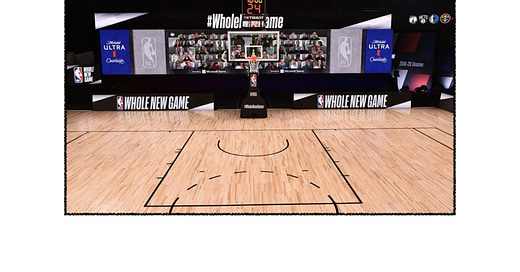




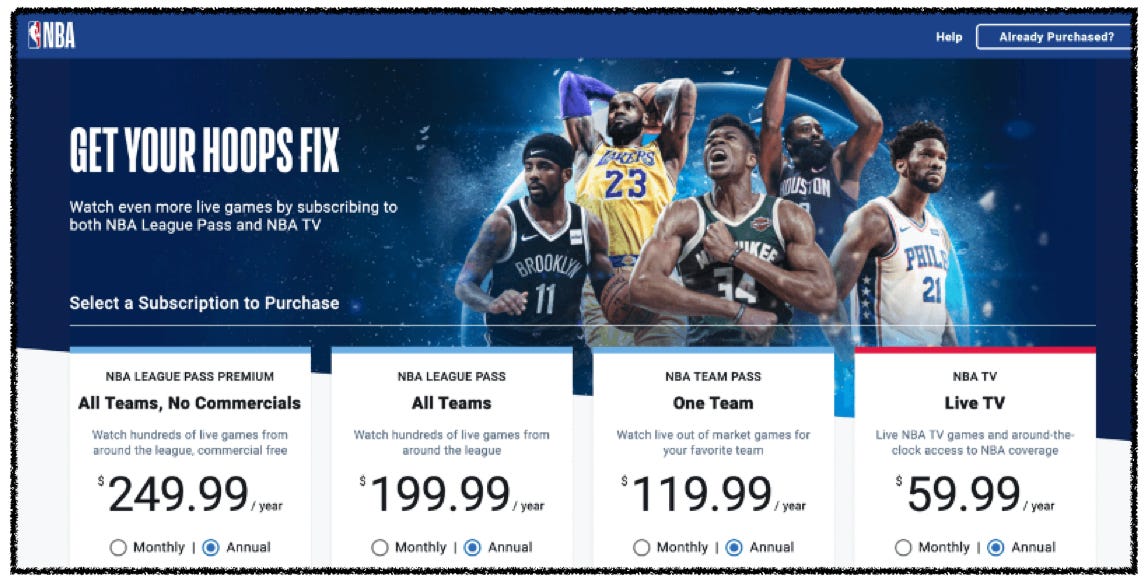
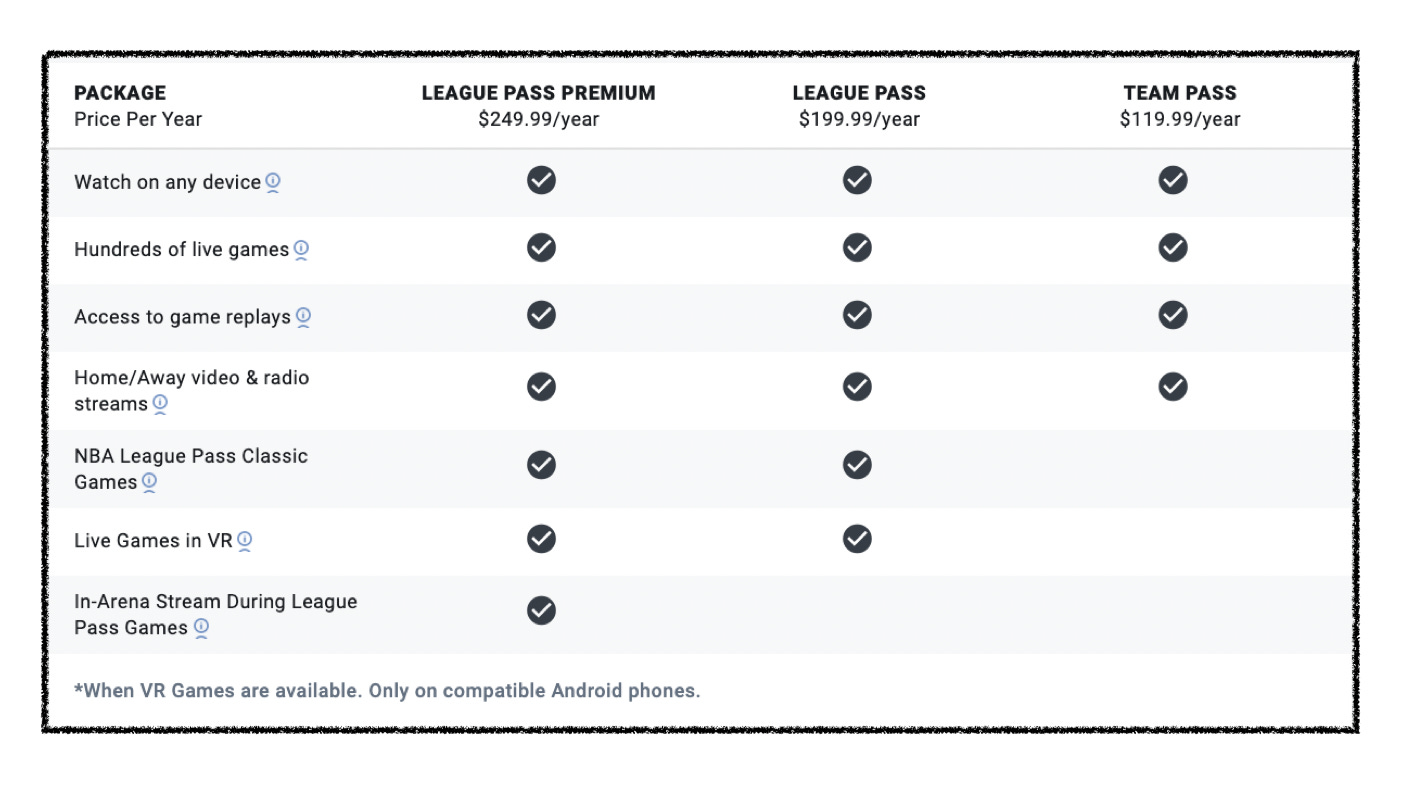
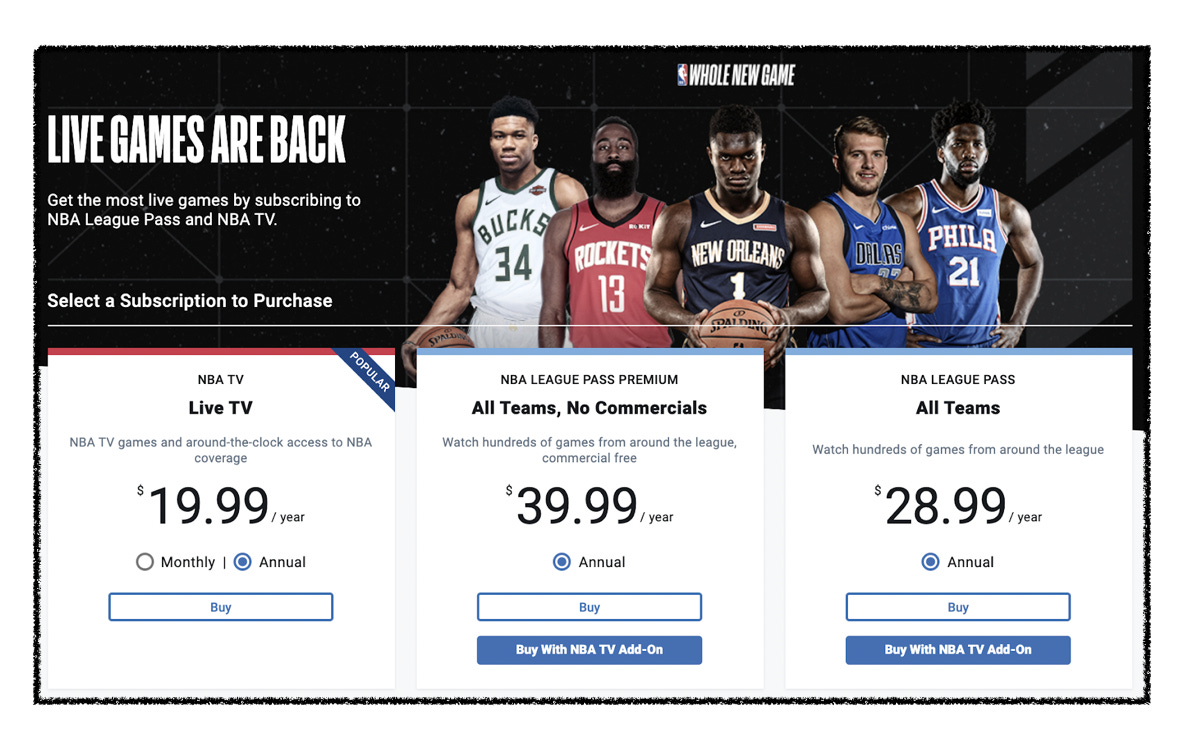
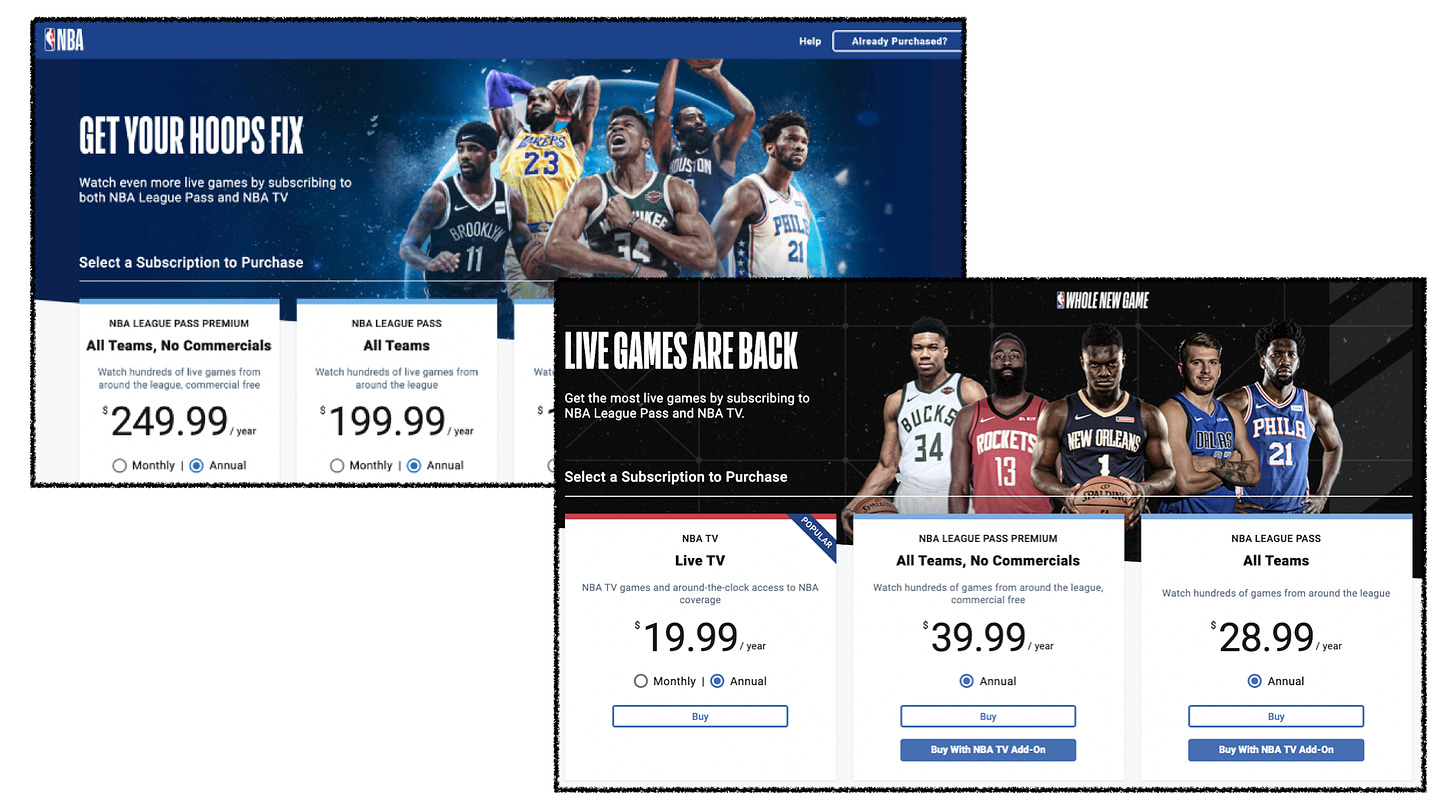
Would be interesting to see the price per available game/watched game and whether this offer is similar in price to expected watched game for the full season.
These prices appear to be annual/rolling subscriptions so potentially are a big discount IF the next season starts and runs successfully. In this scenario there will be a bunch of renewals at an interesting time.